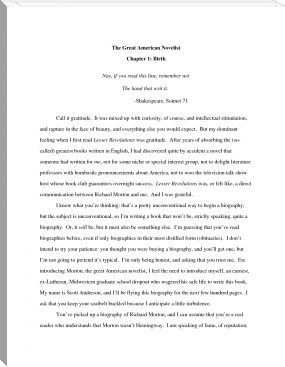The Ocean and Its Wonders by R. M. Ballantyne (free novel reading sites .TXT) 📖

- Author: R. M. Ballantyne
Book online «The Ocean and Its Wonders by R. M. Ballantyne (free novel reading sites .TXT) 📖». Author R. M. Ballantyne
So, then, when we next meet with a huge isolated boulder on any of our flat beaches, we may gaze at it with additional interest, when we reflect that, perchance, it was carried thither by the ocean, countless ages ago, from the arctic regions, on a gigantic raft of ice; after having been, at a still more remote period, torn from its cliffs by some mighty glacier and slowly rolled and rounded, for hundreds of years perhaps down the scarred slopes of its native valley.
The primary cause of the intense and prolonged cold of the arctic regions is the shortness of the time during which they are under the influence of the sun’s rays. For a few months in summer the sun shines brightly, but, owing to the position of the globe, obliquely on the poles. During part of that period it shines at mid-night as well as at mid-day. Put during the greater part of the year its beams throw but a feeble light there, and for several months in winter there is absolutely no day at all—nothing but one long dismal night of darkness, that seems as if the bright orb of day had vanished from the heavens for ever.
The length of this prolonged day in summer, and this dreary night in winter, depends, of course, upon latitude. The length of both increases as we approach the poles. The long daylight in summer is exceedingly delightful. We once saw the sun describe an almost unbroken circle in the sky for many days and nights, and had we been a few degrees further north we should have seen it describe an entire circle. As it was, it only disappeared for twenty minutes. It set about midnight, and in twenty minutes it rose again so that there was no night, not even twilight, but a bright, beautiful blazing day, for several weeks together.
Dr Kane describes the midnight sun thus: “On our road we were favoured with a gorgeous spectacle, which hardly any excitement of peril could have made us overlook. The midnight sun came out over the northern crest of the great berg, our late ‘fast friend,’ kindling variously-coloured fires on every part of its surface, and making the ice around us one great resplendency of gem-work—blazing carbuncles and rubies, and molten gold.”
Very different indeed is the aspect of the winter night. Let the same authority speak, for he had great experience thereof.
On December 15th he writes: “We have lost the last vestige of our mid-day twilight. We cannot see print, and hardly paper. The fingers cannot be counted a foot front the eyes. Noonday and midnight are alike; and, except a vague glimmer on the sky, that seems to define the hill-outlines to the south, we have nothing to tell us that this arctic world of ours has a sun. In one week more we shall reach the midnight of the year...
“The influence of this long intense darkness was most depressing. Even our dogs, although the greater number of them were natives of the arctic circle, were unable to withstand it. Most of them died from an anomalous form of disease, to which I am satisfied, the absence of light contributed as much as extreme cold.” Quoting from his journal he says: “I am so afflicted with the insomnia of this eternal night, that I rise at any time between midnight and noon. I went on deck this morning at five o’clock. It was absolutely dark; the cold not permitting a swinging lamp, there was not a glimmer came to me through the ice-crusted window-panes of the cabin. While I was feeling my way, half puzzled as to the best method of steering clear of whatever might be before me, two of my Newfoundland dogs put their cold noses against my hand, and instantly commenced the most exuberant antics of satisfaction. It then occurred to me how very dreary and forlorn must these poor animals be, at atmospheres 10 degrees above zero in-doors and 50 degrees below zero without—living in darkness, howling at an accidental light, as if it reminded them of the moon—and with nothing, either of instinct or sensation, to tell them of the passing hours, or to explain the long lost daylight. They shall see the lantern more frequently.”
Yet this state of midnight darkness is not altogether unmitigated. There are a few ameliorating influences at work, the nature of some of which we will treat of in the next chapter. Among others, the moon frequently shines there with great brilliancy in winter. Dr Kane says that in October the moon had reached her greatest northern declination: “She is a glorious object. Sweeping around the heavens, at the lowest part of her curve she is still 14 degrees above the horizon. For eight days she has been making her circuit with nearly unvarying brightness. It is one of those sparkling nights that bring back the memory of sleigh-bells and songs and glad communings of hearts in lands that are far away.”
But despite all the varied and transient beauties of the northern skies in winter, the long arctic night is undoubtedly depressing in the extreme. In these regions men speak of being able to read the thermometer on the 7th of November at noonday “without a light,” as being matter for gratulation. The darkness still before them at that time would be of about three months’ duration, and even then they would only get back to a species of twilight.
The cold experienced by these navigators of the northern seas is terribly intense. Their thermometers have frequently indicated a temperature as low as 75 degrees below zero, or 107 degrees of frost, on Fahrenheit’s scale. The thermometers of arctic explorers are always filled with spirits of wine, as quicksilver freezes at about 40 degrees below zero, and is therefore unsuitable. It would be frozen, indeed, the greater part of the winter.
Dr Kane says: “At such temperatures chloric ether became solid, and carefully prepared chloroform exhibited a granular pellicle on its surface. Spirits of naphtha froze at 54 degrees below zero, and oil of sassafras at 49 degrees. The oil of winter-green was in a flocculent state at 56 degrees, and solid at 63 degrees.
“The exhalations from the surface of the body invested the exposed or partially clad parts with a wreath of vapour. The air had a perceptible pungency upon inspiration, but I could not perceive the painful sensation which has been spoken of by some Siberian travellers. When breathed for any length of time, it imparted a sensation of dryness to the air-passages. I noticed that, as it were involuntarily, we all breathed guardedly, with compressed lips.”
Now, strange to say, this extremely low temperature does not affect the ocean to any great depth. Just below the ice, in cold such as the above, the sea was found to be 29 degrees above zero. No doubt, deeper down, the temperature was still warmer. We have heard it said, that when men chance to fall into the water in cold regions, in the depth of winter, it feels at first rather warm and agreeable! On scrambling out again, however, their condition is not enviable; for in a few minutes the keen frost causes their garments to become as hard as boards.
Much light has been thrown on the fact of the existence of under and upper currents in the sea, by the phenomena of the arctic regions, and some of the questions to which these currents give rise are so interesting that we shall treat of them in a new chapter.
It was long and very naturally supposed that the impenetrable ice of the arctic regions extended to, and, as it were, sealed up the pole. But from time to time philosophic observers of Nature’s laws began to hint their opinion that there is an open ocean around the pole; and of late years this opinion has all but been converted into a firm belief.
Maury remarks, that like air—like the body—the ocean must have a system of circulation for its waters. And an attentive study of the currents of the sea, and a close examination of the laws which govern the movements of the waters in their channels of circulation through the ocean, will lead us irresistibly to the conclusion that always, in summer and winter, there must be, somewhere within the arctic circle, a large body of open water.
There is an under-current setting from the Atlantic, northward through Davis’ Straits, into the Arctic Ocean, and a surface-current setting out.
The fact is proved beyond a doubt by the observations of arctic explorers, who have seen immense icebergs drifting rapidly northward against a strong current. This apparent anomaly could only be accounted for by the fact that a powerful undercurrent carried them northward; and as at least seven times more of these bergs must have been under than above water, we can easily understand how the under-current, acting on the larger mass of each berg, had power to carry it against the surface-current.
This under-current is warm, while the upper-current is cold. Now we know that according to Nature’s laws, heated water, like heated air, rises to the surface, and cold water sinks to the bottom. How, then, comes this warm current to be underneath the cold, as soundings have proved it to be? It is owing to the fact that the under-current is much salter, and therefore heavier (despite its warmth), than the surface-current; which latter, being mingled with the drainage and ice-masses of the arctic regions, is comparatively fresh, and therefore light as well as cold.
The hot and salt waters of the tropics are carried north by the Gulf Stream. There are here two counteracting agents at work. Heat inclines the Gulf Stream to rise; saltness inclines it to sink. During the first part of its journey, as we know, its great heat prevails over the other influence, and it flows as a surface-current. But, at a certain point in its northward route, it meets with the cold, brackish, ice-bearing currents that flow out of the arctic basin. Having lost much of its heat (though still possessing a great deal more than the arctic currents), the saltness of the Gulf Stream prevails; it dips below the polar waters, and thenceforth continues its course as an under-current, salt, and comparatively warm.
To state the matter briefly: The hot water, which ought to keep on the surface because of its heat, is sunk by its superabundant salt; and the cold water, which ought to sink because of its cold, is buoyed on the surface because of its want of salt.
Now arises the question—what becomes of the great quantity of salt that is thus being carried perpetually into the polar basin? Manifestly it must be carried out again by the surface-current, otherwise the polar basin would of necessity become a basin of salt. The under-current must, therefore, rise to the surface somewhere near the pole, with its temperature necessarily only a little, if
 Have you ever thought about what fiction is? Probably, such a question may seem surprising: and so everything is clear. Every person throughout his life has to repeatedly create the works he needs for specific purposes - statements, autobiographies, dictations - using not gypsum or clay, not musical notes, not paints, but just a word. At the same time, almost every person will be very surprised if he is told that he thereby created a work of fiction, which is very different from visual art, music and sculpture making. However, everyone understands that a student's essay or dictation is fundamentally different from novels, short stories, news that are created by professional writers. In the works of professionals there is the most important difference - excogitation. But, oddly enough, in a school literature course, you don’t realize the full power of fiction. So using our website in your free time discover fiction for yourself.
Have you ever thought about what fiction is? Probably, such a question may seem surprising: and so everything is clear. Every person throughout his life has to repeatedly create the works he needs for specific purposes - statements, autobiographies, dictations - using not gypsum or clay, not musical notes, not paints, but just a word. At the same time, almost every person will be very surprised if he is told that he thereby created a work of fiction, which is very different from visual art, music and sculpture making. However, everyone understands that a student's essay or dictation is fundamentally different from novels, short stories, news that are created by professional writers. In the works of professionals there is the most important difference - excogitation. But, oddly enough, in a school literature course, you don’t realize the full power of fiction. So using our website in your free time discover fiction for yourself. 




Comments (0)